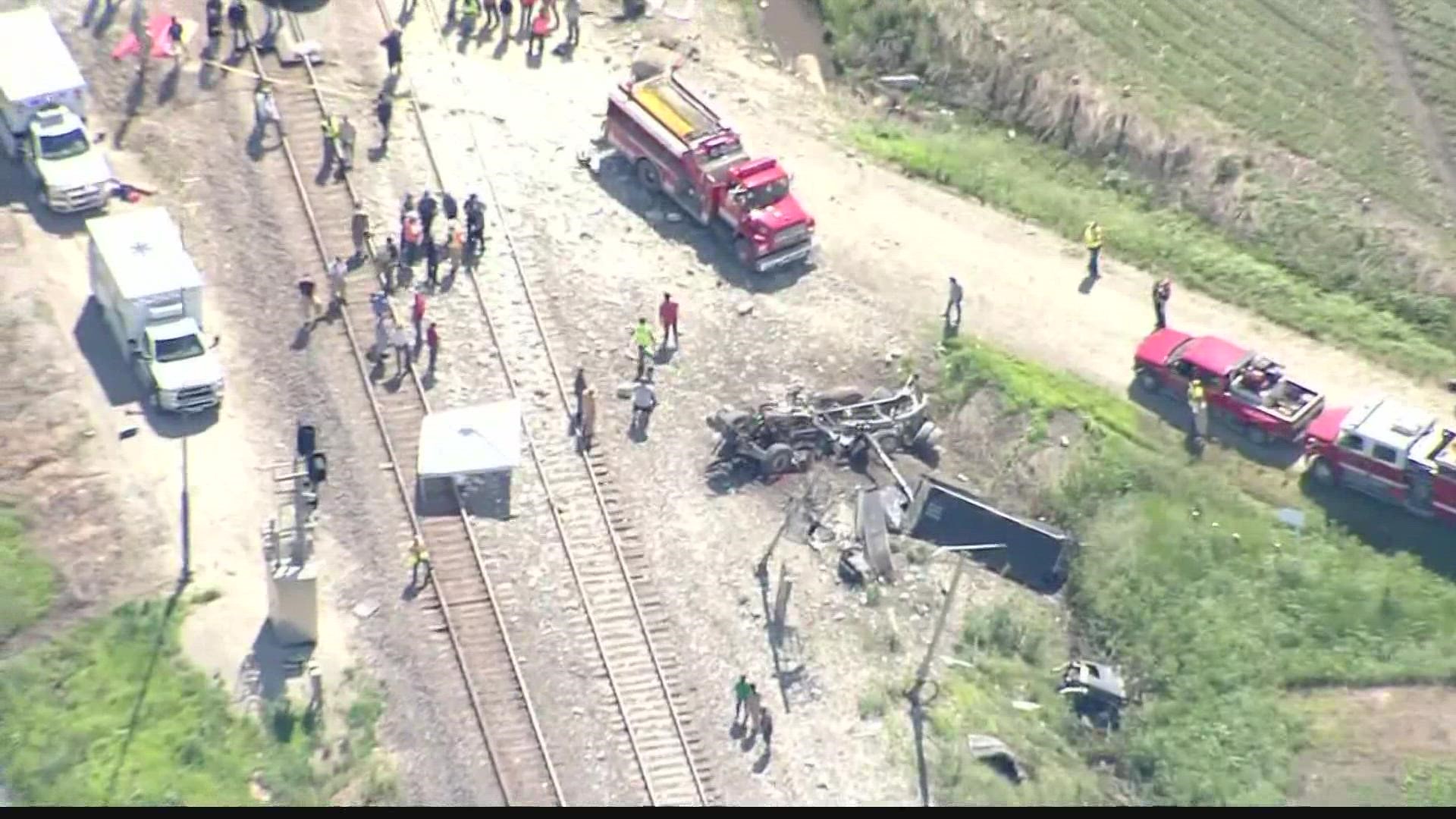MENDON, Mo. — The chief elected official in the Missouri county where an Amtrak train slammed into a dump truck said Tuesday that residents and county leaders have been pushing for a safety upgrade at the railroad crossing for nearly three years. Meanwhile, the toll from the accident rose to four deaths and 150 injuries.
A day after the deadly crash on Monday, the Missouri State Highway Patrol said people taken to 10 hospitals with injuries ranging from minor to serious. By Tuesday afternoon, at least 15 people remained hospitalized. The dead — three passengers and the truck driver — have not been identified.
Amtrak’s Southwest Chief was traveling from Los Angeles to Chicago Monday afternoon when it struck the truck and derailed at the crossing. Amtrak officials said about 275 passengers and 12 crew members were aboard.
The crossing in a rural area near Mendon in western Missouri, about 84 miles northeast of Kansas City, has no lights or other signals to warn of an approaching train.
Chariton County Presiding Commissioner Evan Emmerich said in an email to The Associated Press that resident Mike Spencer first brought his concerns about the crossing to a Dec. 2, 2019, commission meeting. He was told to contact the Missouri Department of Transportation’s Railroad Safety division. A week later, commissioners spoke with officials from the state agency and were told “it is on their plans to repair,” Emmerich said.
After that, Emmerich cited other efforts by the commission. They included a March 2021 meeting with a state Railroad Safety division engineer at the crossing site; an email sent to the Railroad Safety division on May 23 to address concerns about visibility at the crossing; and a May 31 call to BNSF Railway, which owns the track, “to express our concerns with the visibility issue” at the crossing.
In January, the Missouri Department of Transportation submitted to the Federal Railroad Administration its “State Freight & Rail Plan” plan. It included a proposal to install lights and gates, along with roadway improvements. The project was estimated at $400,000. Typically, the federal government would pay 80% and the county 20%.
MoDOT spokeswoman Linda Horn said the crossing near Mendon “is identified for funding for improvements." Neither Horn nor a spokeswoman for Gov. Mike Parson immediately responded to emailed questions about why the county's request wasn't addressed sooner.
BNSF spokeswoman Lena Kent said the company had not been made aware of the state's proposed upgrade. She said the next step would be a site review.
“We would work with all of the parties involved to determine if additional warning devices are needed and then work to get those designed, built and installed,” Kent said.
Spencer told The Associated Press that he is among several people who have complained that the overgrowth of brush and the steep incline from the road to the tracks makes it hard to see oncoming trains from either direction. Spencer, who grows corn and soybeans on land surrounding the intersection, said the crossing is especially dangerous for those driving heavy, slow farm equipment.
Spencer is on the board of a local levy district. He said the dump truck driver was hauling rock for a levy on a local creek, a project that had been ongoing for a couple of days.
Earlier this month, Spencer posted a video on Facebook of the crossing that shows the steep gravel incline leading up to it.
“We have to cross this with farm equipment to get to several of our fields,” Spencer wrote with the posting. “We have been on the RR for several years about fixing the approach by building the road up, putting in signals, signal lights or just cutting the brush back.”
The posting noted that some trains pass by at up to 90 mph (145 kph). “If you cross here with a vehicle stop, approach very slowly, then look both ways there are 2 tracks and around 85 trains go through there everyday,” Spencer wrote.
Passengers recounted the frightening aftermath of the accident.
Rob Nightingale of Taos, New Mexico, said he was dozing off in his sleeper compartment when the lights flickered and the train rocked back and forth and he felt it tip.
"I saw the ground coming toward my window, and all the debris and dust,” Nightingale told The Associated Press. “Then it sat on its side and it was complete silence. I sat there and didn’t hear anything. Then I heard a little girl next door crying.”
Nightingale was unhurt and he and other passengers were able to climb out of the overturned train car through a window.
Passengers included 16 youths and eight adults from two Boy Scout troops who were traveling home to Appleton, Wisconsin, as well as high school students from Pleasant Ridge High School in Easton, Kansas, who were headed to a Future Business Leaders of America conference in Chicago.
It was the second Amtrak collision in as many days. Three people in a car were killed Sunday afternoon when an Amtrak commuter train smashed into it in Northern California, authorities said.
People have been injured or killed in at least six other accidents involving Amtrak trains since 2015. Last year, three people died and others were injured when an Amtrak derailed in north-central Montana as it traveled from Chicago to Seattle.
Amtrak is a federally supported company that operates more than 300 passenger trains daily in nearly every contiguous U.S. state and parts of Canada. The Southwest Chief takes about two days to travel from Los Angeles to Chicago, picking up passengers at stops in between.
___
Ballentine reported from Columbia, Missouri. Associated Press reporters Margaret Stafford in Kansas City, Missouri, and Jim Salter in O'Fallon, Missouri, contributed to this report.

